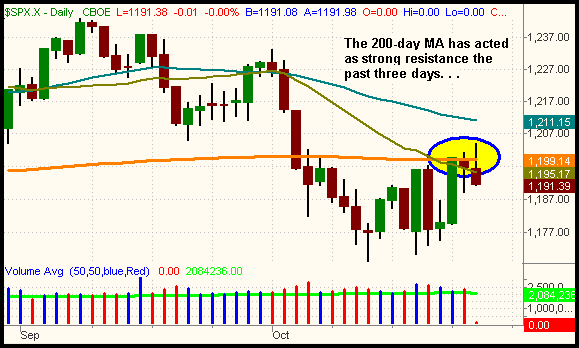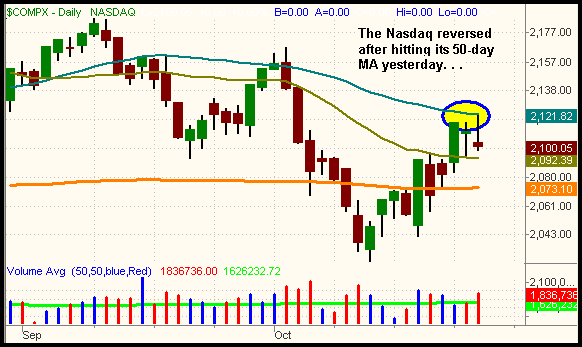These 2 ETF are ready to move
The major indices rallied throughout the first half
of Wednesday’s session, but the bears took control in the afternoon
and caused the broad market to sustain another day of higher volume selling.
Both the S&P 500
(
SPX |
Quote |
Chart |
News |
PowerRating) and Nasdaq Composite
(
COMP |
Quote |
Chart |
News |
PowerRating)Â fell 0.4%,
while the Dow Jones Industrial Average lost 0.3%. The smallcap Russell 2000
(
RUT |
Quote |
Chart |
News |
PowerRating)
and midcap S&P 400
(
MDY |
Quote |
Chart |
News |
PowerRating) both showed relative weakness and lost 0.8% and
0.5% respectively. Computer software and hardware were among the few sectors
that showed strength, as most sectors on our watchlist posted losses. Each of
the broad-based indices also closed at their intraday lows, which often leads to
pressure in the following morning’s session.
Both the S&P 500 and Nasdaq registered their second consecutive “distribution
days,” as volume increased in both exchanges yesterday. Total volume in the
Nasdaq increased by 15%, while volume in the NYSE came in 5% higher than the
previous day’s level. Declining volume exceeded advancing volume by a margin of
nearly 2 to 1 in both exchanges.
Stocks rallied sharply as a knee-jerk reaction to the new Fed chief
announcement on October 24, but it appears that institutions have since used
that strength as a selling opportunity. Although the major indices have not
dropped a significant percentage over the past two days, the fact that they have
declined on higher volume both times is indicative of institutional selling
“under the hood.” If you ignore the volume changes of the past two days, it
simply appears that the broad market has dropped a little bit. But astute
traders who understand the relationship between price and volume will see the
action of the past two days as a warning sign to the bulls. You may recall that
a series of “distribution days” preceded the decline in the first half of
October as well.
Looking at the daily charts of the S&P 500 and Nasdaq, it quickly becomes
apparent why both indices have seen selling pressure the past several days. The
S&P rallied into resistance of its 200-day moving average on October 24, but has
been unable to close above it. Yesterday’s action was bearish because the index
traded well above the 200-MA on an intraday basis, but finished the day well
below it. As you may know, the 200-day moving average often acts like a brick
wall with regard to providing support or resistance. This is because the level
is closely watched by institutions as an indicator of the long-term direction of
an index. The daily chart of the S&P below illustrates how the index has tried
but failed to close above its 200-day MA. Also take note of the wide day to day
indecision throughout the past two weeks — the reason we have recently been
avoiding the broad-based ETFs:

The Nasdaq Composite has been trading above its 200-day moving average for
the past week, but it reversed lower after rallying into resistance of its
50-day moving average yesterday:

The combination of the Nasdaq at its 50-day MA and the S&P at its 200-day MA
has provided a perfect excuse for traders to sell into strength. As such, we
feel now is the time to once again begin testing the waters on the short side of
the markets. Despite the large percentage gains from the rallies of October 19
and 24, it is important to be cognizant of the “big picture.” Each of the major
indices remain clearly in technical downtrends from their highs of either August
or September. Furthermore, there has been only one day of higher volume buying
(“accumulation day”) since the October lows, but there have been numerous days
of distribution. The start of earnings season has certainly resulted in wild
volatility from day to day, but the overall downtrend remains intact and odds
still favor the short-side of the broad market.
Because SPY (S&P 500) is below its 20, 50, and 200-day moving averages, it
has less support and more overhead resistance than an ETF such as
(
QQQQ |
Quote |
Chart |
News |
PowerRating) (Nasdaq
100), which is currently above all three of those MAs.
(
DIA |
Quote |
Chart |
News |
PowerRating) (Dow Jones)
also has a lot more overhead supply than QQQQ, but be aware that the Dow has
been extremely volatile over the past week. Overall, ETFs with the most relative
weakness to the broad market present the best shorting opportunities. Upon
determining which ETFs you wish to short, consider using the hourly charts to
determine your short entry points. Regular subscribers will see that we are
targeting SPY for a potential short entry today because it broke support of its
hourly uptrend line into yesterday’s close. We also continue to stalk
(
GLD |
Quote |
Chart |
News |
PowerRating)
for potential long entry.
Open ETF positions:
We are currently flat (regular subscribers to
The Wagner Daily receive detailed stop and target prices on open
positions and detailed setup information on new ETF trade entry prices. Intraday
e-mail alerts are also sent as needed.)
Deron Wagner is the head trader of Morpheus Capital Hedge Fund and founder of
Morpheus Trading Group (morpheustrading.com),
which he launched in 2001. Wagner appears on his best-selling video, Sector
Trading Strategies (Marketplace Books, June 2002), and is co-author of both The
Long-Term Day Trader (Career Press, April 2000) and The After-Hours Trader
(McGraw Hill, August 2000). Past television appearances include CNBC, ABC, and
Yahoo! FinanceVision. He is also a frequent guest speaker at various trading and
financial conferences around the world. For a free trial to the full version of
The Wagner Daily or to learn about Deron’s other services, visit
morpheustrading.com or send an e-mail
to
deron@morpheustrading.com .
